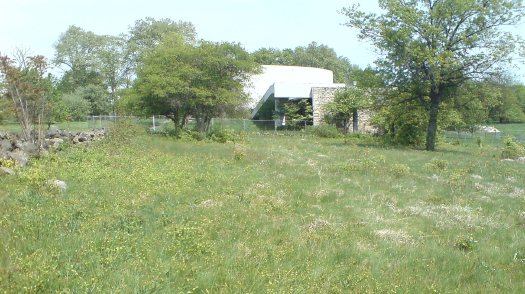
The Park Service’s stated goal for Gettysburg is the “rehabilitation” of the battlefield to its 1863 condition by removing modern structures like Richard Neutra’s Cyclorama Center [designed, it should have been noted a long time ago, with Robert Alexander] and the visitors center next to it [already gone] which are built on “hallowed ground.” Which is not quite so simple.
In Gettysburg: memory, market and an American shrine, his 2003 history of the ongoing cultural battle over the site and its meaning, Jim Weeks looked at the controversy over the Park Service plan to create a big, new privately operated visitor center/museum offsite. This wasn’t “Disneyfication,” it was, in the words of John Latscher, the Gettysburg superintendent who spearheaded the deal, “re-sanctifying” the battlefield. [emphasis added on the tiny but powerful rhetorical device that automatically transforms anyone who disagrees into John Wilkes Booth.]
The rehabilitation/re-sanctification plan to remove post-1863 structures does have some loopholes: anything in the middle of the battlefield but on private land across the street, as long as it serves popcorn chicken and/or deliciously dark chocolate pies for a limited time only; the 1392 or 1600 markers and monuments placed by “the veterans themselves,” or whomever; and the three remaining observation towers the War Department built.
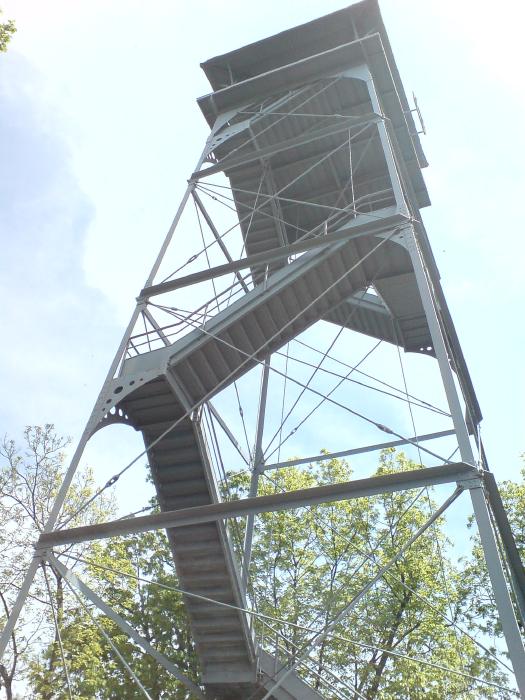
Let me go on record that, should it ever be threatened with demolition, I will email every architect and journalist I know to save the observation tower on West Confederate Avenue; that thing is a freaking masterpiece. Let’s get that out there right now, because I don’t find much information or discussion about it at all. [Here’s another of the three, dated 1895, the year the War Dept took charge of the Memorial Park, which is super-short. It looks like there were structural problems, and it was chopped in 1960. Note that it wasn’t torn down completely; I think I’ll come back to that in a minute.]
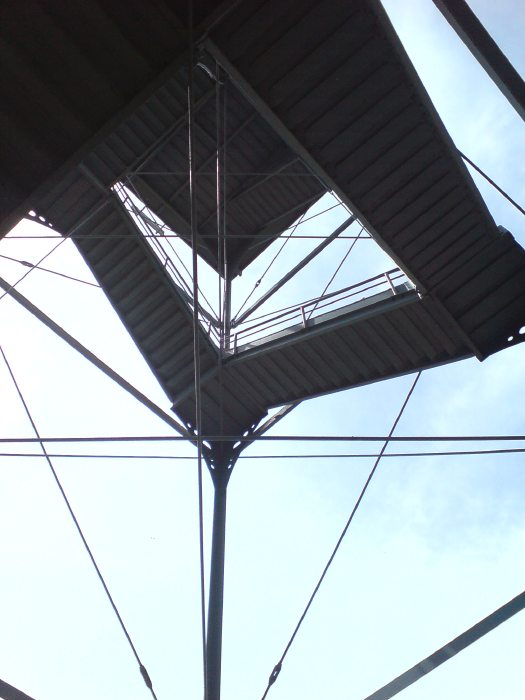
What do you get for your steep, 6-7 story climb up the steel cage? A great view, of course. But also understanding. Context. Orientation. It’s the place where people tell stories of troop movements and battle strategies. There is much pointing. All across a vast landscape like this, we saw people orienting themselves, spotting landmarks, and telling stories. They were mapping the action and the meaning, translating history onto the site in front of them.
Weeks’ book notes that observation points have been a popular and vital feature of visitors’ experience at Gettysburg from very early on. Some are natural spots, like the promontories of Little Round Top and the Copse of Trees at Cemetery Ridge. Some were built, like Round Top Park, the War Dept. towers [there used to be five], the Pennsylvania State Monument–and the Cyclorama Center. The biggest observation tower, built on private land, was seized and destroyed in 2000 after an intermittent, 26-year legal battle. Weeks draws the connection between the dioramas and orientation maps, the cycloramas–almost all of which had their origins in commercial/entertainment enterprises–and the site itself; arguably, facilitating this mental transition from representation to site was the major justification for placing the Cyclorama so close to its focal point, the top of Cemetery Ridge, in the first place.
One common feature of these observation points is the orienting device: arrows pointing toward key sites or events. Here is the welded steel plate on the War Dept tower:
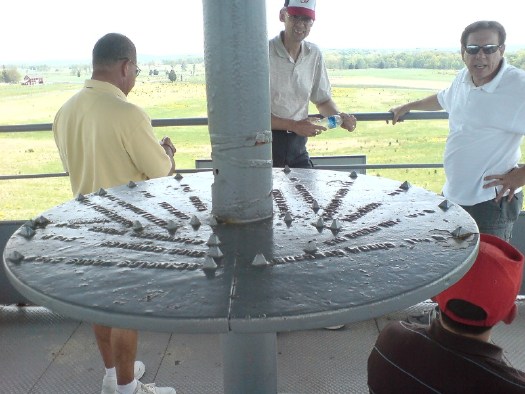
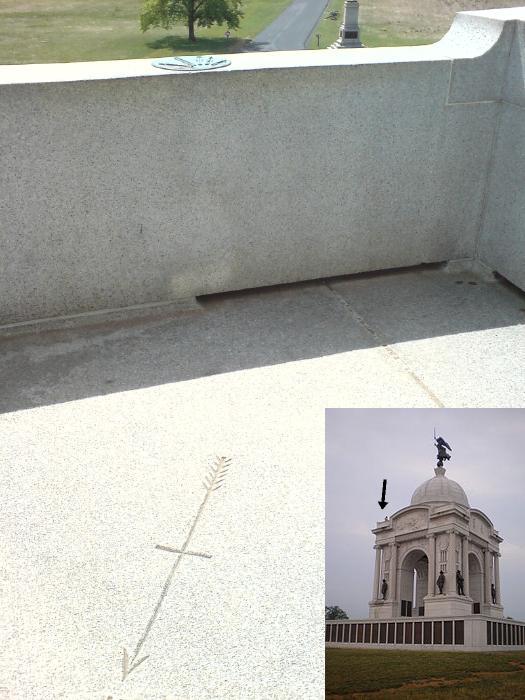
Which was the third one I noticed, after [1] the compass mark handcarved into the granite floor and [2] the incredible cast bronze plaques on the parapets of the Pennsylvania State Monument. [Which, by the way, is a gigantic Beaux Art mess, a Columbia Exposition knockoff whose looming, continued presence exposes the whole idea of re-creating the 1863 battlefield to be little more than conceptual cover fire to advance a subjective set of pre-determined alteration strategies.]
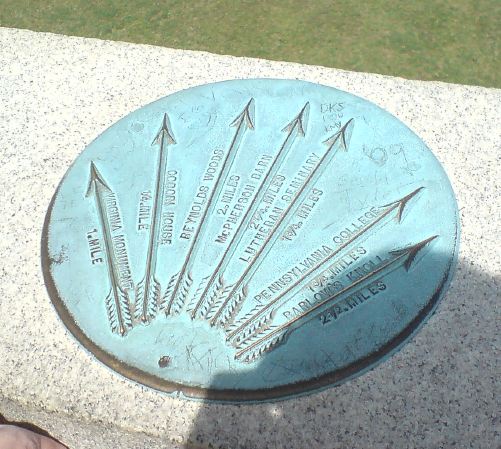
These arrows, on these structures, point, I believe, to a possible future for Neutra’s Cyclorama: restore and reconfigure it as an observation and orientation platform for Cemetery Ridge. Neutra already included an observation platform and ramp [see house industries’ photo below]; adapting the empty rotunda for observation would hew close to the building’s original function on its original site, while minimizing the loss of Neutra’s and Alexander’s key design elements.
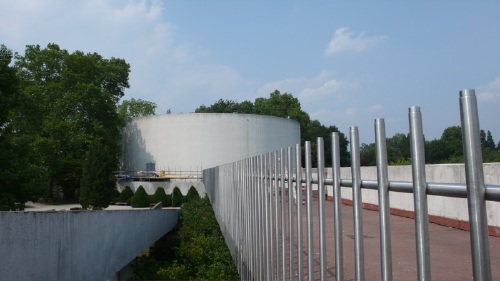
Then there’s precedent: the Park Service’s stated strategy of 1863 rehabilitation nevertheless preserves several post-1863 observation structures, including the unassailable Pennsylvania Monument and three of the five towers apparently installed by the War Department at the founding of the Memorial Park. One is apparently historical and/or functional enough to preserve even after being truncated to just one story up–roughly the same height as the Cyclorama’s existing deck.
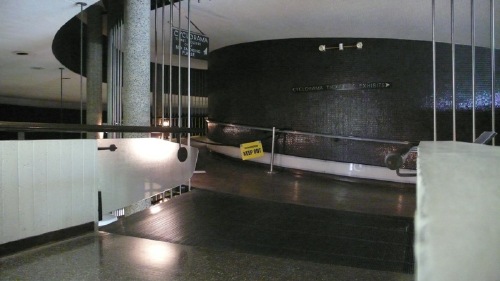
A Cyclorama Observation Platform would also offer something completely unique: accessibility. All other observation spots we saw involved stairs, curbs, or uneven wooded trails. [The Pennsylvania Monument’s vantage point is reached by a single, awesomely treacherous spiral staircase lined with stamped bronze paneling that’d do a SoHo loft ceiling proud.] Much of the battlefield itself–and thus the monuments scattered across it–quickly becomes inaccessible to disabled or wheelchair-using visitors.
An entirely ramp-based observation structure would enhance the battlefield experience for millions of visitors who would otherwise be confined to their cars. [Oh, look! Neutra’s already got two ramps built right in! image above: houseindustries.com]
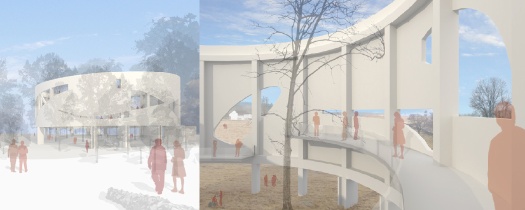
In fact, a speculative observation platform proposal has already been floated. The Boston-based architecture firm CUBE design + research used Neutra’s Cyclorama Center to illustrate a range of alternatives to strict historical preservation. One idea [above]: turning the Cyclorama as “informant” and “information hub,” by making strategic, view-framing cuts in the rotunda. It’s a pretty radical alteration, the kind of thing that keeps traditional preservationists up at night. And as proposed/rendered, I think many of Cube’s solutions go way too far. But they’re spurring discussion, not answering an RFP, and in that, they succeed.
Piercing Neutra’s rotunda in places might still work, perhaps in combination with another of CUBE’s suggestions, to place the Park Service’s historic electric relief map in the building. Or perhaps a large-scale relief map could be made for blind visitors to gauge the scale and detail of the terrain. In either case, a multi-sensory narrative program could be devised that integrates such artifacts with views out of the building onto the actual battlefield. [Something like the light and sound effects on the new Cyclorama installation, which seem to be state-of-whatever-art-these-sorts-of-things-are.]
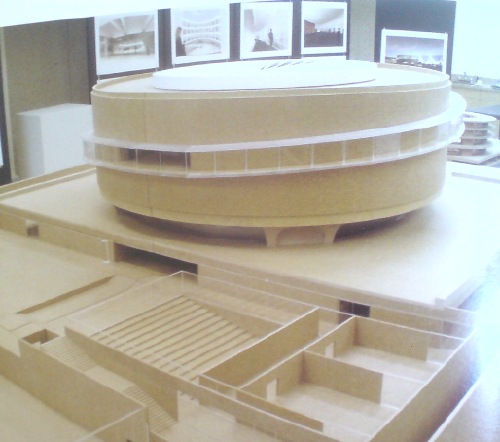
Another possibility just came to me this morning: the 2006 proposal Olafur Eliasson made for the Hirshhorn Museum, a similarly love-to-hate, modernist concrete barrel on a major civic site. Eliasson proposed wrapping Gordon Bunshaft’s building with a suspended glass walkway that afforded sprawling views of the National Mall, something akin to the exterior escalator tubes at the Pompidou. [images: from the bookshelf-straining insanity that is Taschen’s Studio Olafur Eliasson: An Encyclopedia.]

Maybe an information-filled ramp could spiral up the inside of Neutra’s rotunda–a history of the wounded, perhaps, and their heroism and their tales of endurance and remembrance–and then let visitors out to wind their way down the outside, where they could then descend along the original ramp onto the battlefield itself. At least as far as their wheelchairs can take them.
The Park Service and Gettysburg Foundation claim the current battlefield rehabilitation plan provides great “environmental benefits,” even as the courts find they have failed to undertake the basic impact studies required by law.
Worse than this, though, is the active, and ongoing denial of the equality of us all–by denying equal access to key parts of the battlefield experience, such as observation platforms–on the very battleground of freedom made sacred by the sacrifices of life. And limb.
Next: Observations from/on Towers and The Wound Dresser, set in stone, rest stops on the journey Toward a Cyclorama-shaped Gettysburg Memorial to The Wounded
Skip to content
the making of, by greg allen
